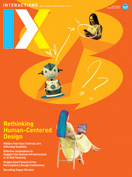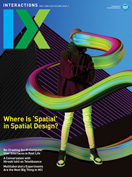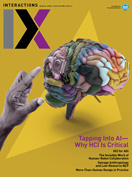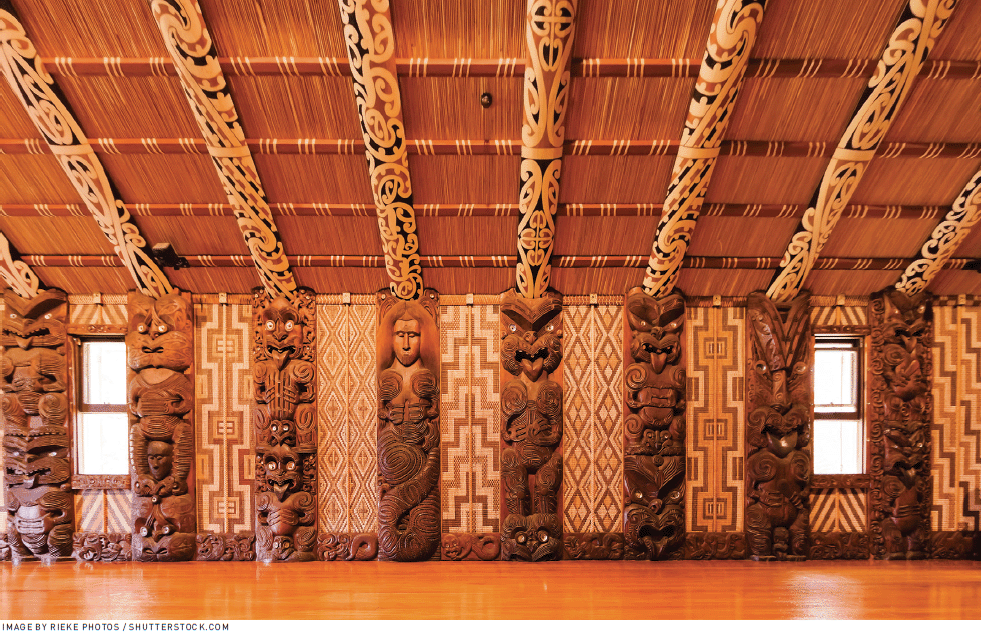Authors:
Daria Loi, Penny Hagen
In my previous column, I discussed key themes related to participatory practice outside of academia, leveraging a book chapter that I recently coauthored with Penny Hagen and Raphael Arar [1]. In this column, I interviewed Penny Hagen, codirector of the Auckland Co-Design Lab, to outline a specific section of the same chapter, which focused on decolonial practice, with an emphasis on government contexts.
In our chapter, we discuss increased public sector attention on participatory design to address complex socioeconomic issues. In Australia and New Zealand, participatory practices inspired by Eurocentric approaches have been introduced into places with a history of colonization and oppression of Indigenous practices. Can you share more about your experiences in these contexts?
These reflections are shaped by my experience as a non-Indigenous practitioner. I came to understand participatory design (PD) as it was shared with me through its Scandinavian academic traditions, in the context of Australia and New Zealand. My perspective is informed through the opportunity to work alongside Indigenous practitioners leading in this space, including lab codirector Angie Tangaere (Ngāti Porou), and the lab's active engagement with Indigenous practitioners [2].
Participatory design, or codesign as it is more widely known here, was rapidly adopted over the past decade within the public sector. It has been promoted as an approach for working with Indigenous or Traditional Owner communities to address health and social inequity challenges. Codesign has even been a requirement for new policy and services. PD and codesign are imbued with the intent of emancipation, participation, and rights. This seems positive, but its application needs to be seen within a broader historical context. Depending on how and by whom it is practiced, codesign risks being an imported process that perpetuates colonial and Eurocentric mindsets and values. Indigenous practitioners, such as Rita Estelle Wakefield [3], note that Indigenous communities have been the subject of both past and ongoing acts of racist violence and oppression, which dismantled strong cultural and economic structures. These communities are now the focus of innovation and codesign efforts ostensibly aimed at "lifting the health and social outcomes" [3]. The problem is that codesign is being used to imply the existence of power sharing but without the acknowledgment of the underlying behaviors and structures that caused harm in the first place. Without this happening first, any attempt to bring participatory value is likely to cause further harm. Meaningful efforts to codesign with Indigenous communities must be led by Indigenous communities, centered in existing wisdoms, knowledge, and strengths, and they should advance self-determination [4,5,6].
What are some of the challenges that you have observed in this context and some of the responses?
Cultural safety and cultural capability are an obvious starting point. Can codesign be led by non-Indigenous practitioners to research or organize Indigenous communities? Do non-Indigenous practitioners have the ability to support culturally appropriate protocols and perspectives? The experience shared by many Indigenous communities and practitioners is that they most often should not and do not.
Codesign risks being an imported process that perpetuates colonial and Eurocentric mindsets and values.
Codesign processes driven from Eurocentric perspectives often focus on the human and individual experience, omitting dimensions and perspectives that are central to Indigenous worldviews. Those include relationship to land, country, and place; ensuring Te Taiao (the environment) is at the center; and connecting to tūpuna (ancestors), history, customary practices, and knowledge. This speaks to the depth of cultural knowledge that may not be recognized or understood by PD or non-Indigenous practitioners.
There are also times when codesign has been co-opted as a term to describe what is still just a consultation process. Even when the intent is to involve communities more actively, processes remain driven by external timelines and financial constraints, sitting at odds with relational approaches. The co part becomes optional. When operating in the context of historical trauma and harm, the priority is trust building, healing, and recognition of past harm. These tend to not be reflected in a project plan.
Codesign and the associated notions of systems thinking have also often been presented as new. This risks ignoring innovation and participatory practices already present and with long histories in Indigenous communities. As Dana Shen states, "We already think in complex systems and family systems" [5]. Much of what codesign seeks to introduce is understood as the natural way of working with whānau (family) [2].
In response, we have seen extensive work to develop participatory approaches that more effectively balance and draw upon both Indigenous and Eurocentric worldviews. Government teams are working with Indigenous practitioners to develop processes and frameworks that use culturally grounded methodologies and worldviews as the starting point and bring specific cultural expertise into the process. There is also growing visibility of practices that supersede a Eurocentric model of codesign by returning to or starting within culture and cultural practice.
For example, Angie Tangaere, the lab's codirector, has guided the development of a whānau-led innovation practice that is culturally grounded [5]. Māori practitioner Karl Wixon (Waitaha, Kāti Mamoe, Kāi Tahu, Ngāti Toa Rangatira, and Moriori) refers to whakapapa-led design, where the protocols of marae (traditional meeting houses) are the process. Tokona te Raki, the innovation arm of Ngāi Tahu, is also sharing the iwi's (tribe's) Indigenous-led design practices, known as Te Korekoreka, having returned to them after exploring Eurocentric approaches. These ways of being, doing, and designing recognize and make visible Indigenous-led methods once again and reclaim practices that start in place, culture, and country.
As coauthor of our chapter, I was in a position to deepen my understanding of the fixation that Eurocentric codesign places on human and individual experiences, as well as the omission of dimensions and perspectives that are central to Indigenous worldviews. One thing that stood out relates to the issues of identity, and the call to create time within the PD process for engaging in deep personal work. What have been some of your experiences in this area?
A key starting point is the recognition of multiple worldviews. As Tristan Schultz [7] highlights, Indigenous folks are always operating in at least two worlds. Understanding that there are different worlds and that we might need to move beyond that, negotiate, and give more balance to Indigenous worldviews—this is the work that non-Indigenous practitioners need to do.
Indigenous folks are always operating in at least two worlds.
The concept of cultural safety, as well as the existence of safe and brave spaces, is consistent. This refers to spaces where Indigenous practitioners can do the work in culturally grounded ways, as well as spaces for both non-Indigenous and Indigenous people to do the deeper work of recognizing, unlearning, positioning, and letting go. This work requires non-Indigenous people and allies to have honest and challenging conversations. Creating time and space for this must be prioritized even when it clashes with time constraints. These efforts imply a need for PD practitioners to be self-reflective; have cultural humility and respect; challenge structural racism, as well as individual and organizational white privilege; and reflect on our own bias and privilege, and how words, actions, and language may reinforce the systems that get in the way. Shen offers points of guidance for non-Indigenous codesign practitioners, including what allyship means: to "work to support the self-determination of Aboriginal people in the codesign process and in true partnership." Such work requires one to be willing to create true partnerships with people, ensuring they listen, learn, seek guidance and embrace directions following proper protocols and ways of working [5].
This work requires non-Indigenous people and allies to have honest and challenging conversations.
The chapter [1] that Penny Hagen and I coauthored includes a set of questions, listed below, that offers the opportunity to reflect on decolonial PD practice and its many ramifications at personal as well as institutional levels:
- What does it mean to see Eurocentric PD as only one of many relational, participatory, and values-led design and innovation traditions?
- How are we paying attention to what is needed to grapple with positionality as inherent in PD work? What is one's personal work alongside the design process?
- Is there sufficient readiness to actively commit to allyship, personal discomfort, the work of challenging racism, and the potential personal costs that this process might entail?
- How might we ensure the creation of safe spaces for this work so it becomes part of the PD process?
- If PD isn't led by Indigenous communities, or making its way there, and it isn't an explicit act of allyship, is it helpful/meaningful/relevant/justified in these contexts?
We wish to acknowledge Raphael Arar, coauthor of the book chapter mentioned at the beginning of this article, and his valuable contributions, which were foundational in developing this article.
1. Loi, D., Hagen, P., and Arar, R. Participatory design beyond academia. In Routledge International Handbook of Contemporary Participatory Design, R.C. Smith, D. Loi, H. Winschiers-Theophilus, L. Huybrechts, and J. Simonsen, eds. Routledge, New York, forthcoming.
2. Schollum-Whaanga, D., Goodwin, D., Hagen, P., Albarrán González, D., Joyce, M., and Burke, K. Māori co-design ethics hui summary. Ngā Aho Incorporated Society, Auckland, 2019; https://www.knowledgeauckland.org.nz/media/2217/m%C4%81ori-co-design-ethics-hui-7-aug-2019-summary-july-2020.pdf
3. Wakefield, R.E. What is co-design in a Māori space? Kotahitanga in action. Waipareira Journal 3 (2019); https://wairesearch.waipareira.com/wp-content/uploads/2019/11/Rita-Wakefield-What-is-Co-Design-in-a-M%C4%81ori-Space.pdf
4. Davis, K. How social innovation is deeply Māori. Innovation Unit, 2018; https://www.innovationunit.org/thoughts/how-social-innovation-is-deeply-maori/
5. Shen, D. and Charles, V. An Aboriginal perspective on co-design and self-determination. The Australian Centre for Social Innovation, 2022; https://www.tacsi.org.au/aboriginal-perspective-on-co-design-and-self-determination
6. Tangaere, A. and Hagen, P. Tikanga-led design: Whānau-led innovation for systems transformation. In Entanglements of Designing Social Innovation in the Asia-Pacific, Y. Akama, and J. Yee, eds. Routledge, New York, 2023.
7. Schultz, T. Decolonising design in practice. Social Design Sydney, 2021; https://www.youtube.com/watch?v=zfySygiIib8
Daria Loi combines design strategy with experience research and innovation to enrich people's lives and humanize technology. She is the founder of Imperfecta, an art and design gallery focused on women artists and minority creatives, and is Oregon City's arts commissioner. She serves on DemocracyLab's board of directors, and is an honorary professor at the University of Newcastle, Australia. [email protected]
Penny Hagen is codirector of the Auckland Co-Design Lab, a public sector learning and innovation unit based in Aotearoa (New Zealand). She has supported cross-sector teams and communities in tackling complex social issues by connecting policy and evidence to the lived realities and aspirations of people. [email protected]
Copyright 2025 held by owner/author
The Digital Library is published by the Association for Computing Machinery. Copyright © 2025 ACM, Inc.









Post Comment
No Comments Found